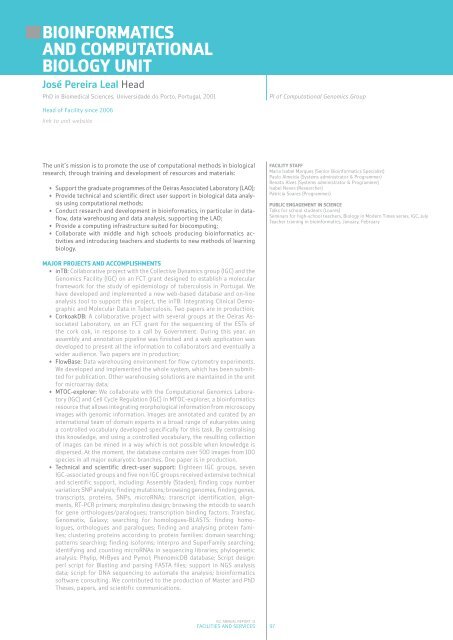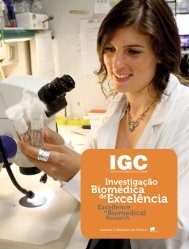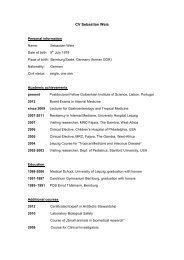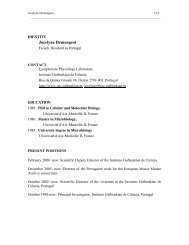organisation - the Instituto Gulbenkian de Ciência
organisation - the Instituto Gulbenkian de Ciência
organisation - the Instituto Gulbenkian de Ciência
- No tags were found...
Create successful ePaper yourself
Turn your PDF publications into a flip-book with our unique Google optimized e-Paper software.
BIOINFORMATICS<br />
AND COMPUTATIONAL<br />
BIOLOGY UNIT<br />
José Pereira Leal Head<br />
PhD in Biomedical Sciences, Universida<strong>de</strong> do Porto, Portugal, 2001<br />
PI of Computational Genomics Group<br />
Head of Facility since 2006<br />
link to unit website<br />
The unit´s mission is to promote <strong>the</strong> use of computational methods in biological<br />
research, through training and <strong>de</strong>velopment of resources and materials:<br />
• Support <strong>the</strong> graduate programmes of <strong>the</strong> Oeiras Associated Laboratory (LAO);<br />
• Provi<strong>de</strong> technical and scientific direct user support in biological data analysis<br />
using computational methods;<br />
• Conduct research and <strong>de</strong>velopment in bioinformatics, in particular in dataflow,<br />
data warehousing and data analysis, supporting <strong>the</strong> LAO;<br />
• Provi<strong>de</strong> a computing infrastructure suited for biocomputing;<br />
• Collaborate with middle and high schools producing bioinformatics activities<br />
and introducing teachers and stu<strong>de</strong>nts to new methods of learning<br />
biology.<br />
FACILITY STAFF<br />
Maria Isabel Marques (Senior Bioinformatics Specialist)<br />
Paulo Almeida (Systems administrator & Programmer)<br />
Renato Alves (Systems administrator & Programmer)<br />
Isabel Neves (Researcher)<br />
Patrícia Soares (Programmer)<br />
PUBLIC ENGAGEMENT IN SCIENCE<br />
Talks for school stu<strong>de</strong>nts (Loures)<br />
Seminars for high-school teachers, Biology in Mo<strong>de</strong>rn Times series, IGC, July<br />
Teacher training in bioinformatics, January, February<br />
MAJOR PROJECTS AND ACCOMPLISHMENTS<br />
• inTB: Collaborative project with <strong>the</strong> Collective Dynamics group (IGC) and <strong>the</strong><br />
Genomics Facility (IGC) on an FCT grant <strong>de</strong>signed to establish a molecular<br />
framework for <strong>the</strong> study of epi<strong>de</strong>miology of tuberculosis in Portugal. We<br />
have <strong>de</strong>veloped and implemented a new web-based database and on-line<br />
analysis tool to support this project, <strong>the</strong> inTB: Integrating Clinical Demographic<br />
and Molecular Data in Tuberculosis. Two papers are in production;<br />
• CorkoakDB: A collaborative project with several groups at <strong>the</strong> Oeiras Associated<br />
Laboratory, on an FCT grant for <strong>the</strong> sequencing of <strong>the</strong> ESTs of<br />
<strong>the</strong> cork oak, in response to a call by Government. During this year, an<br />
assembly and annotation pipeline was finished and a web application was<br />
<strong>de</strong>veloped to present all <strong>the</strong> information to collaborators and eventually a<br />
wi<strong>de</strong>r audience. Two papers are in production;<br />
• FlowBase: Data warehousing environment for flow cytometry experiments.<br />
We <strong>de</strong>veloped and implemented <strong>the</strong> whole system, which has been submitted<br />
for publication. O<strong>the</strong>r warehousing solutions are maintained in <strong>the</strong> unit<br />
for microarray data;<br />
• MTOC-explorer: We collaborate with <strong>the</strong> Computational Genomics Laboratory<br />
(IGC) and Cell Cycle Regulation (IGC) in MTOC-explorer, a bioinformatics<br />
resource that allows integrating morphological information from microscopy<br />
images with genomic information. Images are annotated and curated by an<br />
international team of domain experts in a broad range of eukaryotes using<br />
a controlled vocabulary <strong>de</strong>veloped specifically for this task. By centralising<br />
this knowledge, and using a controlled vocabulary, <strong>the</strong> resulting collection<br />
of images can be mined in a way which is not possible when knowledge is<br />
dispersed. At <strong>the</strong> moment, <strong>the</strong> database contains over 500 images from 100<br />
species in all major eukaryotic branches. One paper is in production.<br />
• Technical and scientific direct-user support: Eighteen IGC groups, seven<br />
IGC-associated groups and five non IGC groups received extensive technical<br />
and scientific support, including: Assembly (Sta<strong>de</strong>n); finding copy number<br />
variation; SNP analysis; finding mutations; browsing genomes, finding genes,<br />
transcripts, proteins, SNPs, microRNAs; transcript i<strong>de</strong>ntification, alignments,<br />
RT-PCR primers; morpholino <strong>de</strong>sign; browsing <strong>the</strong> mtocdb to search<br />
for gene orthologues/paralogues; transcription binding factors: Transfac,<br />
Genomatix, Galaxy; searching for homologues-BLASTS: finding homologues,<br />
orthologues and paralogues; finding and analysing protein families;<br />
clustering proteins according to protein families: domain searching;<br />
patterns searching; finding isoforms; Interpro and SuperFamily searching;<br />
i<strong>de</strong>ntifying and counting microRNAs in sequencing libraries; phylogenetic<br />
analysis: Phylip, MrByes and Pymol; PhenomicDB database; Script <strong>de</strong>sign:<br />
perl script for Blasting and parsing FASTA files; support in NGS analysis<br />
data; script for DNA sequencing to automate <strong>the</strong> analysis; bioinformatics<br />
software consulting. We contributed to <strong>the</strong> production of Master and PhD<br />
Theses, papers, and scientific communications.<br />
IGC ANNUAL REPORT ‘11<br />
FACILITIES AND SERVICES<br />
97






